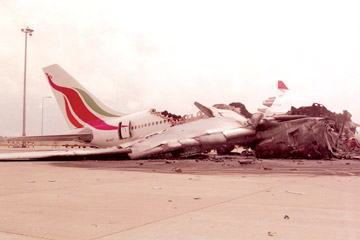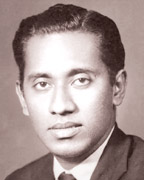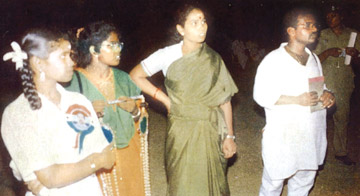LTTE's ferocity knew no bounds
by Janathri Nanayakkara
One cannot comment on the movie Madras Café, without understanding
the dynamics of Lankan history sans bias. Suhrith Parthasarathy, the
author of the New York Times article 'Bad history mars Indian movie on
Rajiv Gandhi's assassination', fails to do just that.
|

The SriLankan Airlines plane blown up by the LTTE |
The events in Sri Lanka were not as simple as what Suhrith
Parthasarathy portrays them to be. Most of the roots of the three
decade-long violence in Sri Lanka lie in the 133 years of colonial rule.
The British, true to their colonial principle of 'divide and rule',
favoured the minority communities over the majority Sinhalese and sowed
the seeds of division among one another. A century of oppression of the
majority Sinhalese, by the British, gradually resulted in the
antipathy-fed rift in the social fabric of Sri Lanka. To illustrate,
until 1948 (Sri Lankan's Independence), 94 percent of senior civil
servants were Tamil (population 12 percent - 1946 census). This was
because the schools providing English education, which was required for
government jobs, were mainly in Tamil-dominated Jaffna.
The introduction of democracy to Sri Lanka became the gateway that
allowed all communities access to equal opportunity.
It turned things around for the majority Sinhalese, as it gave them a
voice, which they used to realign the equation. The privileges enjoyed
by the minority communities themselves (Tamil and Burgher) during the
colonial era were no longer a 'birthright'.
The seeming shift of power from the minority, especially that of the
Tamil elite, was received with unease. However, what may have pushed the
Tamil community was the 1972 Policy of Standardisation, that rectified
disparities in university enrollment since colonial rule.
Tamil leadership
 |
 |
| Alfred
Duraippah |
Rajiv Gandhi |
In the 1960s, documents relating to a separate socialist Tamil state
began to circulate based on the legend of the Chola kingdom, which in
10th century ruled South India and extended to other parts of Asia as
well.
Several impatient Tamil youth, who were enlisted in the Liberation
Tigers of Tamil Elam (LTTE), carried out several hit-and-run operations
against moderate Tamil politicians, Sri Lanka Police, and civil
administration, against the wishes of the older Tamil leadership.
Contrary to author Parthasarathy's allegations, Black July of 1983 was
sparked by the LTTE, through a series of events. To list a few:
1975 assassination of the democratically elected Tamil Member of
Parliament and Mayor of Jaffna, Alfred Thambirajah Duraiappah
1976 robbing of the People's Bank at Puttur of Rs. 668,000
1977 shooting of Tamil Member of Parliament P.C. Karunandhi
1978 murder of the Leader of Tamil United Liberation Front (TULF)
K. Kanagaratnam
1978 assassination of Tamil Police Inspectors Bastianpillai,
Pathmanathan, Kumaru and Perampalan during the investigation of
Kanagaratnam's murder
|

The suicide bomber who killed Rajiv Gandhi (second from left) |
1978 killing of Sinhalese Constable Kingsley Perera and Tamil
Civilian Satchithanadan during LTTE's Rs. 1,000,000 raid on the People's
Bank at Nallur.
1978 bomb explosion on an Air Ceylon plane flying from
Kankesanturai (Jaffna District) to Colombo.
1979 massacre of Tamil civilians S.A. Emmanuel of Chankanai, Thaadi
Thangarajah, A. Krishnagol, T. Poopalasingham and A. Sivarajah of
Thondamannar for providing evidence against the LTTE to the Sri Lanka
Police.
1979 murder of Tamil Police officers Gnanasambandan, Sivanesan,
Guruswamy, and S. Swarnarajah and their families.
Subsequently, the final straw was the 1983 murder of 13 Sri Lanka
military officers.
Ferocity
Disastrously, some of the Sinhalese were provoked by the LTTE's
ferocity, which led to dangerous riots that caused the blemish in the
Sri Lankan psyche, the bloody "1983 Black July". While many innocent
Tamils lost their Iives, many more fled the country. However, it is
scarcely noted, how most Sinhalese at the risk of their own lives
sheltered their Tamil brethren from the angry mobs.
The incident was just what the LTTE was waiting for, to mobilise the
support of the Tamil masses to their cause. It was the beginning of the
brutal terrorist war, triggered by suicide bombings and ambush attacks.
The Sri Lanka Government moved on to lifting the Policy of
Standardisation, hoping the compromise would encourage talks with the
LTTE. However, they had other plans by then.
The LTTE's desire for a mono-ethnic separate state in the North and
the East included the slaughter and displacement of over 100,000 Muslim
and Sinhalese men, women, and children. The 1985 massacre in
Anuradhapura at the sacred Sri Maha Bodhi of nearly 230 Sinhalese,
mainly women and children, is one among many LTTE atrocities. In 1986
thousands of Muslims were given 48 hours to leave the North. The gross
violence in the North and the East against Muslims and Sinhalese by the
LTTE had the effect that they desired.
By 1991, in an unprecedented act of ethnic cleansing, the LTTE rid
the North of all other communities. Many Tamil civilians living in the
North and East, who didn't share the LTTE ideology, were violently dealt
with.
The 1986 torture and killing of 34 Tamil civilians near Batticoloa
for refusing to take arms for the group is another grim reminder.
Education
Even during the height of war against terrorism the Sri Lanka
Government ensured that the citizens of the North and the East had
access to publicly funded education, universal health care, food, and
clean water, and safe shelter for thousands of Tamil families fleeing
the LTTE controlled areas.
The government prioritised the maintenance of civil infrastructure,
including salaries for the civil servants even in areas under the LTTE.
Most Tamils trapped in the North sought an escape from the LTTE's
grip. It was the expatriate Tamils and sympathisers who kept the LTTE's
dream alive for another two decades by funding them with millions of
dollars each year.
Unfortunately, many Tamils who were affected by the conflict in Sri
Lanka (through cultural ties or otherwise) so easily overlook what truly
was taking place.
The events were not simple as what Suhrith Parthasarathy infers in
his article, where the LTTE seems to be the champions.
Although they professed to be freedom fighters, the LTTE, soon
evolved in to a terrorist outfit proscribed in many democratic
countries.
They no longer cared about the cost of their terror campaign, but
only of power and a future where Velupillai Prabhakaran would be the 'Eelam
king'.
A true champion of its people, would not, snatch children from their
families and forcefully enlist them as child soldiers, torture and kill
his people if they did not abide by his wishes, promote propaganda which
made his people fear other communities, repress education within the
community, or brainwash his cadres to become suicide bombers.
Jan Goodwin's, Marie Claire article, 'When a Suicide Bomber is a
Woman', puts LTTE in its true perfection, as it depicts a first-hand
account of a captured female suicide bomber.
Therefore, Parthasarathy, before you criticise a Bollywood movie on
its marred history, it would be appropriate if you get your facts
straight. |

